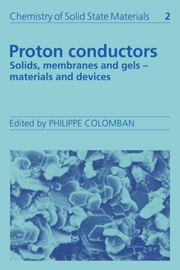Book contents
- Frontmatter
- Contents
- List of contributors
- Preface
- Symbols
- I HYDROGEN BOND AND PROTONIC SPECIES
- II MATERIALS: PREPARATION, STRUCTURES AND PROPERTIES
- III PROTON DYNAMICS AND CHARGE TRANSPORT
- IV PROTON DIFFUSION MECHANISMS
- V DEVICES
- 32 Applications of perfluorinated proton conductors (Nations)
- 33 Synthesis of polycrystalline H3O+ and NH4+ -β″/β-Al2O3 and potential applications in steam-electrolysis/fuel-cells
- 34 Fuel-cells, steam-electrolysis for hydrogen production and hydrogen separation using high temperature protonic conductors
- 35 Ice-based devices
- 36 Solid-state gas sensors operating at room temperature
- 37 All solid-state protonic batteries
- 38 Applicatios of proton conductors in electrochromic devices (ECDs)
- 39 Supercapacitors and interfacial charge accumulation devices
- Index
34 - Fuel-cells, steam-electrolysis for hydrogen production and hydrogen separation using high temperature protonic conductors
Published online by Cambridge University Press: 04 May 2010
- Frontmatter
- Contents
- List of contributors
- Preface
- Symbols
- I HYDROGEN BOND AND PROTONIC SPECIES
- II MATERIALS: PREPARATION, STRUCTURES AND PROPERTIES
- III PROTON DYNAMICS AND CHARGE TRANSPORT
- IV PROTON DIFFUSION MECHANISMS
- V DEVICES
- 32 Applications of perfluorinated proton conductors (Nations)
- 33 Synthesis of polycrystalline H3O+ and NH4+ -β″/β-Al2O3 and potential applications in steam-electrolysis/fuel-cells
- 34 Fuel-cells, steam-electrolysis for hydrogen production and hydrogen separation using high temperature protonic conductors
- 35 Ice-based devices
- 36 Solid-state gas sensors operating at room temperature
- 37 All solid-state protonic batteries
- 38 Applicatios of proton conductors in electrochromic devices (ECDs)
- 39 Supercapacitors and interfacial charge accumulation devices
- Index
Summary
Introduction
Although there are many protonic conductors which are stable at low temperatures (< 200 °C), they are not suitable for high electrolytic current applications because of their large electrode polarization. Therefore, their usage is probably limited to sensors in which only a voltage signal is valuable.
In contrast to this, high temperature protonic conductors are applicable both to sensors and high electrolytic current usage, e.g. electrolysis, galvanic cells for power supply, etc. since, at high temperature, electrode reactions are able to proceed smoothly and, in general, polarization is small. In Table 34.1, possible applications of high temperature proton conducting solid electrolytes are listed, classifying them as having either an electromotive function or a preferential permeation of protons.
In this chapter, the distinctive features of proton conductors as an electrolyte for use in a fuel cell or in a steam electrolyser are discussed in comparison to those of oxide ion conductors. In addition, the possibility of using a proton conductor in a hydrogen gas separator is also described. As examples, the experiments on fuel-cells, steam electrolysers and hydrogen gas separators using proton conducting, perovskite-type oxides are described.
Fuel-cells
The use of a proton conducting solid electrolyte in a fuel-cell has distinctive features compared with that of oxide ion conductors. illustrated in Fig. 34.1, when a protonic conductor is used, fuel circulation is unnecessary in a hydrogen fuel-cell because no water molecules are generated at the fuel electrode.
- Type
- Chapter
- Information
- Proton ConductorsSolids, Membranes and Gels - Materials and Devices, pp. 511 - 522Publisher: Cambridge University PressPrint publication year: 1992
- 6
- Cited by



